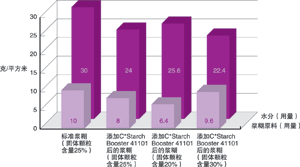As carton companies continue to pursue the production of corrugated cartons at low cost, investment in wide-format, high-speed tile line production equipment has become the industry standard. The faster gluing machine will inevitably need to use a different paste recipe than ever to increase production efficiency. This poses a challenge for the paste manufacturers – they must produce paste products that are suitable for both high-speed tile lines and slow-wattage wire production. In addition, in addition to increasing production speeds, carton companies are also required to produce more fine micro-wavy paperboards, white-faced papers and coated linerboards to help improve the production quality and print quality of cartons. These high quality papers are less porous than standard recycled linerboards and therefore the moisture content of the paste used must be tightly controlled to prevent blisters during the printing process. Therefore, the application of new paste and adhesive formulations is imperative. Obviously, not only is the type of paste important for board production, but the rheology of the paste is also a key issue affecting the bonding effect. To solve this problem, Cargill Industrial Paste will introduce C*Starch Booster 41101, which can adjust the rheology of paste, to the market. It has obtained a license from Corrutech. The corrugated box industry has been using paste for decades. Starch Booster (Paste Enhancer) is a brand new product that can be used to produce new pastes. Cargill said that using Starch Booster can bring the following benefits: Higher average linear speed on tile lines and processing equipment improves board quality (flatter, reduced boardlining, better printability) In Table 1, according to Cargill's estimates, a typical tile line typically consumes 10 grams per square meter of paste when producing B-board. This means that 30 g/m 2 of water can be added to a standard 25% dry paste particle to obtain the desired result (see Table 1). Adding 0.5% C*Starch Booster 41101 to the paste can save at least 20% of the paste. The amount of dried paste particles was reduced to 8 g/m2 while the amount of water added was reduced to 24 g/m2. With the same gluing gap, reducing the amount of paste particles can reduce the amount of paste used by 20%, so that the amount of water added slightly increases to 25.6 g/m 2 . This is much lower than the consumption of raw materials for pastes configured with standard 25% dry paste particles. If the machine is to use a higher solids content, use the same paste addition amount and add C*Starch Booster 41101, but the amount of water used will be reduced by 25%. reduce waste Changes in the properties of the paste make it possible to increase the speed of the tile. Even when the equipment is running at maximum speed, Cargill claims that using the C*Starch Booster will also make the bond strength safer and provide better quality assurance. In addition, since the amount of water used is reduced, the flatness of the paperboard is effectively improved and the subsequent processing problems are reduced. When printing microwatt products, printability can be greatly improved. Some carton companies reported that they could reduce paperboard waste by 50% during printing. This can: Reducing the weight of the outer paper reduces the occurrence of the washboard phenomenon and reduces board waste The printability of the board has been strengthened because the washboard phenomenon has been reduced and the board is flatter. This will also reduce the production of waste products on flexo presses. And higher processing efficiency is another big advantage. In some carton enterprises, the production speed of tile lines often fails to keep up with the speed of processing equipment. These characteristics of the new paste formula can increase the output of the factory. Lower paper weight With the C*Starch Booster 41101, the ECT and BCT values ​​can be increased by 20%. These advantages can all be used to reduce the weight of the paper, while also saving energy and expenses. The United Kingdom is a country that leads the trend of low-weight cardboard. Now, France and Italy have the same trend. Due to the lower temperatures required for low-weight paperboard, the production of low-weight paperboard requires different paste formulations. If you do not use C*Starch Booster, this step is difficult to achieve. In actual use, Cargill concluded that when using the C*Starch Booster, the energy consumption for the production of 1 square meter of cardboard was reduced, the moisture content throughout the production process was reduced, and the production speed of the machine was increased (mostly It is the production of five-layer cardboard and micro-wavy paperboard, and there is no need to adjust any machine production parameters. For simple cardboard grade production (B楞, C楞, and lower grams of cardboard), it is only necessary to change the preheating or reduce the steam pressure. Fred Andriessen, Technical Manager of Cargill's Industrial Paste Company, said: “The corrugated box industry is changing and we believe that the C*Starch Booster 41101 is a promising product that will play an important role in the future of the corrugated box manufacturing industry. The plan is the driving force of our progress. Our in-depth understanding of the corrugated box manufacturing industry can help us continuously raise our awareness and accumulate experience and knowledge." Source: Global corrugated box industry
Reduce tile waste (at least 0.5%)
Reduce paste usage (up to 30% reduction)
The ability to process low-weight paperboards at the expense of reduced mechanical properties or print quality due to lower temperature during production, thus saving energy consumption (calculated per square meter of board), 
Save energy
Energy efficient new paste additive